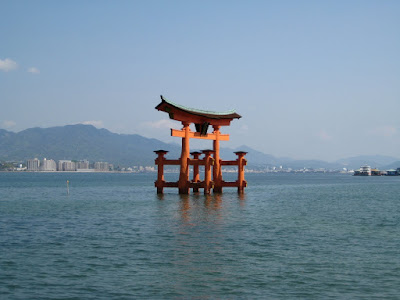Completely awestruck from my experience at the Church of Light, I came back to our residence and attempted to import pictures from my camera. After it “finished” copying all of the images, the program asked if I wanted to keep or delete the duplicates that remained on the camera. I chose “Delete,” which on a normal day works perfectly fine. Today, however, was the one exception. The program crashed. None of the images made it on to my computer, and barely any remained on the camera.
Disappointed by this, I resolved to visit the church on my own. I contacted the pastor and scheduled an appointment for the following Saturday, a day that coincided with our first week of travel. Given the circumstances, I had a limited amount of time to view the church before our departure. Thus, I left early and expected to be back in Kyoto that afternoon.
Over the course of the upcoming week, we would rely fully on the Japan Rail pass for unlimited transportation on any JR line, including the high-speed bullet trains. For the sake of being prepared, I had obtained mine early in the morning. This enabled me to ride the bullet train to Osaka, cutting a significant amount of time out of my trip.
After arriving at Ibaraki station, I discovered that I had no change in my pocket. I also noticed that I had forgotten to bring my wallet, and therefore had no means of obtaining any money. Oddly enough, I had a pocket full of US dollars, but because the banks were all closed, I had no means of exchanging any of it. Thus, I was unable to buy a bus ticket, and was forced to walk. After a half hour on foot, I was standing in front of the church only to discover that it had closed, and that it would be another two hours before I could go in. I was frustrated.
At this point I had to make a decision. I could either accept the fact that the odds were against me, and return back to Kyoto, or I could keep myself occupied while waiting for the church to open. Should I wait, I would be forced to rush back to the station, as everyone back in Kyoto was meeting up an hour later. I couldn’t bring myself to leave without pictures of the church, and concluded that I needed to wait.
I decided to walk around town for a while, but given that I had no money, I could not stop anywhere to get lunch. Instead, my meal for the day consisted of a loaf of bread, a leftover from our kitchen that had been cleaned out for the move. After an extended period of walking around aimlessly, I headed back to the church. The wait proved to be worth it, as I got to experience the building on a more personal level, without the noise of 18 other students. The space inside was calm, offering an undisturbed silence. It was truly amazing.



Upon the conclusion of my visit, I ran back to Ibaraki station. Just as I was about to walk through the gate, I noticed that I no longer had the rail pass. I searched my bag numerous times, but found nothing. Either it fell out somewhere, or someone had picked it out of my pocket. At that moment, I realized that I was stranded. I had no money, which meant that I could not buy a ticket or contact anyone. To add insult to injury, the loss of the rail pass meant that I had just thrown away close to three-hundred dollars.
After attempting to communicate in Japanese with the employees at the station, I was able to convey what had happened. A man took my exchange voucher for the pass and went into the back for a while. At this point I was hopeful that somehow, out of some act of grace, I would be given another pass. The hard reality hit when he returned with a photocopy and a note that read in English, “We will make an effectual search of it.”
I asked if I could make a call, and explained that I had no money, following which he provided me with a cell phone. I called my professor, who decided that someone would branch off and pick me up. My friend, Trent, immediately stepped up.
I waited, briefly retracing my steps and finding nothing. An hour passed, and no one arrived. I walked around the station, every 5 minutes glancing back at the gate, seeing crowds of unfamiliar faces. I waited… and waited… and still, no sign of Trent. At this point, I became very worried, and was positive that he had misunderstood where I was. An hour turned into two hours, which then turned into three. When you are conscious of time, it begins to move very slowly. This is something that I felt, as my eyes continually watched the minutes pass. It was now very dark and rainy outside.
I decided that it was hopeless, and walked to the edge of the station thinking that I might have more luck searching for an abandoned rail pass. I was on the verge of giving up and was literally walking away when something made me turn around. Ten minutes later, my friend walked through the gate.
I cannot begin to describe the immense feeling of relief that swept through me. Up until this point, I had been running scenarios through my head. I was under the impression that I would have to wait in the station all night, alone, hoping for an opportunity to exchange money the following morning. I literally had no options.
The day ended with us checking into our hotel in Hiroshima, ten minutes before our room was given up to other customers. A frustrating and uncertain event, but I did my best to remain optimistic, in spite of the situation. It was a rough start to what our professor termed "A week off."






















































